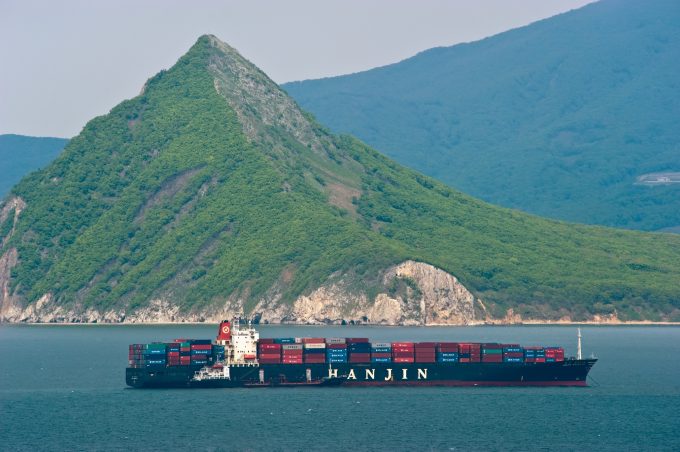FMC demands more info from Premier Alliance to assess its 'competitive impacts'
The US Federal Maritime Commission (FMC) has issued a request for more information from ONE, ...
FDX: ABOUT USPS PRIVATISATIONFDX: CCO VIEWFDX: LOWER GUIDANCE FDX: DISRUPTING AIR FREIGHTFDX: FOCUS ON KEY VERTICALFDX: LTL OUTLOOKGXO: NEW LOW LINE: NEW LOW FDX: INDUSTRIAL WOESFDX: HEALTH CHECKFDX: TRADING UPDATEWMT: GREEN WOESFDX: FREIGHT BREAK-UPFDX: WAITING FOR THE SPINHON: BREAK-UP ALLUREDSV: BREACHING SUPPORTVW: BOLT-ON DEALAMZN: TOP PICK
FDX: ABOUT USPS PRIVATISATIONFDX: CCO VIEWFDX: LOWER GUIDANCE FDX: DISRUPTING AIR FREIGHTFDX: FOCUS ON KEY VERTICALFDX: LTL OUTLOOKGXO: NEW LOW LINE: NEW LOW FDX: INDUSTRIAL WOESFDX: HEALTH CHECKFDX: TRADING UPDATEWMT: GREEN WOESFDX: FREIGHT BREAK-UPFDX: WAITING FOR THE SPINHON: BREAK-UP ALLUREDSV: BREACHING SUPPORTVW: BOLT-ON DEALAMZN: TOP PICK

In the wake of the Hanjin bankruptcy, THE Alliance has devised a “catastrophic instrument” funding mechanism, to be used if one of its member lines were to fail.
The proposals would allow fellow alliance lines to “take other actions to facilitate the movement or cargo carried by the affected party to the intended port of discharge or other locations”.
Other clauses give the members the right to deal directly with shipowners of chartered-in ships and/or other carriers providing slot charters to the bankrupt partner.
The wording within a draft agreement filed with the US Federal Maritime Commission (FMC) by alliance members Hapag-Lloyd, K Line, MOL, NYK and Yang Ming, seeks to restore shipper confidence in the vessel-sharing concept, which was badly dented by the sudden collapse of the South Korean carrier.
Details of THE Alliance initiative were confirmed by FMC commissioner William Doyle in a speech to the North Atlantic Ports Association on Thursday.
The “framework language” in section 7.4 of the VSA, said Mr Doyle, meant that “for the first time, we are seeing an alliance agreement attempt to make projections on ways to deal with a failed carrier in an alliance”.
THE Alliance also wants to be able to “make arrangements directly with agents or subcontractors of the affected party”.
Commissioner Doyle said he had had “direct discussions with principals of THE Alliance” on the terms of the provision, and admitted he was “an advocate of alliance members providing safeguards in the event of future liner bankruptcies”.
He said: “Though the details have not been completely worked out, the intent in part is to set up a per se catastrophic instrument that could be used when an individual member liner fails in the network.”
After Hanjin entered court receivership on 31 August, around 500,000 teu of its cargo, with an estimated value of $12bn and loaded on some 100 containerships, was held up by the immediate withdrawal of credit facilities at ports and terminals, causing mass disruption to supply chains.
Hanjin’s CKYHE alliance partners, Cosco, K Line, Yang Ming and Evergreen, also faced the ire of customers who found it difficult to comprehend why containers they had not booked with Hanjin were also subject to severe delay.
However, the FMC still has “serious concerns” about THE Alliance’s “proposed language in the agreement related to the joint contracting and purchasing power” of the VSA.
Commissioner Doyle said he had expressed these concerns with the principals of THE Alliance and was confident that the parties would “submit appropriate substitute language to alleviate these concerns”.
He said this would bring THE Alliance agreement into parity with the rival 2M and Ocean alliance agreements, on the basis that it would “not be fair to grant ocean carriers the ability to jointly contract and procure services while domestic service providers cannot negotiate collectively”.
The new alliance networks begin operations in April.
Comment on this article
Brad Fallon
December 05, 2016 at 6:18 pmMr. Wacket writes,
“The wording within a draft agreement filed with the US Federal Maritime Commission (FMC) by alliance members Hapag-Lloyd, K Line, MOL, NYK and Yang Ming, seeks to restore shipper confidence in the vessel-sharing concept, which was badly dented by the sudden collapse of the South Korean carrier.”
I take issue with the word “SUDDEN”. There was nothing sudden or unexpected with the collapse of Hanjin. In fact, anyone in this industry of ours that did not know the likelihood of this back in late 2015 – is sadly out of touch. The ocean carriers and the freight forwarders all like to bandy about this notion that we were all taken by surprise when this happened, but the fact is that the ocean carriers, particularly those in the CKYHE Alliance, simply neglected the situation due to its complexity. On the forwarder side of things, the less ethical found great deals booking with Hanjin, and were comfortable in the fact that when the whole mess fell apart, they could simply just bill out any extra charges to their customers with and claim that there was little to no warning of this bankruptcy.
Mike Wackett
December 07, 2016 at 4:48 pmHi Brad
I agree that there was an accident likely to happen in liner shipping, but not necessarily involving Hanjin.
In fact at the turn of the year it was Hanjin’s compatriot, HMM, that appeared to be in the most trouble.
And it was not only shipowners, bunker suppliers, ports and terminals and agents etc that got suckered into the ‘too big to fail’ swagger of Hanjin’s execs; it was also accountants and even lawyers – in fact a total of 3,854 creditors at the last count!